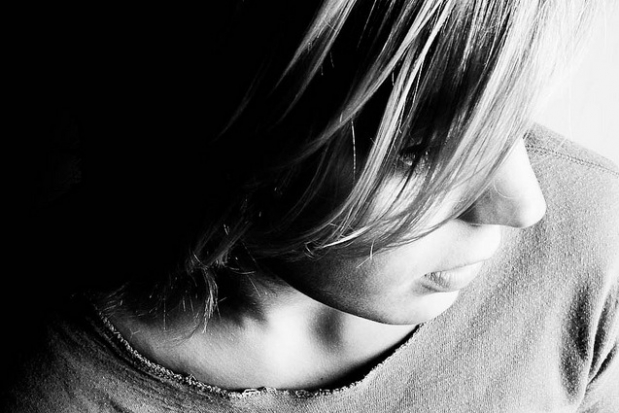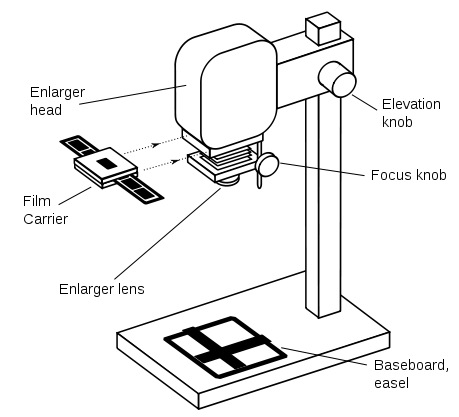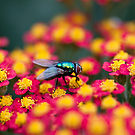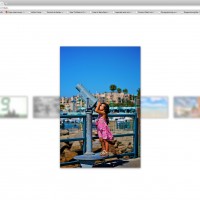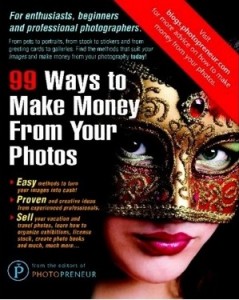
A few years ago, I was part of a creative arts project in Arizona and southern Utah, where we did a lot of work with Native American people — a ‘world through our eyes’ type thing. One of the things that was brought up when we were dealing with more traditional tribes, was that we weren’t to take any photos. Perhaps surprisingly, some people believe that when you take photos of them, you steal a part of their soul.
Religions and superstitions aside, I think it’s a good way to look at portraiture. Stealing souls is a bit harsh, but if your photographs don’t at least borrow a little bit of soul from your subjects, I believe you may have failed as a photographer.
For this article, I’ve chosen to do a critique some of the photos submitted to me by Isaac – an USC film student with a passion for photography. His images illustrate very well how adding a touch of feel (or soul, if you will) can lift your portraiture.
With his photos, Isaac included a note. Now, normally, I don’t pay much heed to what people say about their photos: if they can’t stand on themselves, they aren’t worth critiqueing. In this case, I made an exception: Essentially, Isaac is begging to be kicked to the kerb:
Compliments are nice, but for someone in my position they are useless – I’m a newb and I need people to tear my work apart so that I can improve. Please, please, I beg you, be as harsh as you possibly can. Thanks.
… Which I would have done, if his pictures were actually bad. Luckily, they aren’t. Without any further ado…
Isaac’s first photo has is titled ‘arms’:

At first, I wasn’t quite sure what to feel about this photo. It’s terribly messy, and you can’t actually see anything of what is going on. I’m also not a big fan of the photographer being reflected in the camera, on a general basis. In this one, however, the expression of the photo comes together in a wonderful way.
To me, it seems as if this photo is taken in a changing room. The girls are performers, preparing to go on stage, perhaps. The girl on the left is showing a slightly worried expression, and is looking at the photographer through her hand in the mirror, while the other model is completely obscured in what seems like a dancer’s pose. Is she snapping her fingers? Is she fixing her hair?
The tension in this photo — and much of its soul — comes from the tension in the photograph. The photographer is intruding into a world where he doesn’t belong, and the way the models obscure their own face almost seems as a defensive gesture, even though the body language of both girls are very open.
Along with the tension and the colour repetition (there is only one accent colour, and it’s pink. It’s reflected in the light source, on the photographer’s shirt, in the left girl’s hair band and the right girl’s top), the thing that intrigues me about this photo is that you can follow the path of the light. Take the left model, for example, you can see her head, then her head in the mirror. You can then follow the light beam through the hand which is obscuring her face, which you can also see in the mirror, and then into the photographic lens. As a photographer, this multi-layered self-referential image is very appealing and exciting to me.
On a technical level, I would probably have tidied the image up a little bit. Darken the background more, black out the writing (on the mirror? On the photographer’s shirt?), and get rid of everything to the left of the left model, and to the right of the right model. Once that has been done, it will increase the focus of the photograph.
The final thing which makes this image really work for me, is that if anyone has had their soul ‘stolen’ in this image, it’s the photographer himself. The models are obscured, and the only person who you can connect with (despite the camera stuck in front of his face), is the person taking the photo.
A powerful, cheeky, and inventive photo indeed.
In Isaac’s second photo, entitled Mika, he’s using a different set of techniques:

In a way, I really wanted to read a lot of meaning into this photo, but there’s something about it which doesn’t quite allow that for me. The car in itself is delightfully dilapidated, and the dirt, decay and entropy it and the background represents makes a fantastic backdrop for telling a story.
The model is beautiful, and very well captured on your behalf. The problem I have with the image, however, is that she just doesn’t look quite right in her circumstances. The way she is dressed and posed gives the photo an impression of ‘look! an old car! let’s take a picture on it’. If she was dressed differently, there would have been an opportunity for a whole series of different stories worth telling. Dressed very beautifully and glamorously, it could be a story of being lost / being out of ones element. With more frizzy hair, perhaps a scruffy, stained t-shirt, and with dirty, bare feet, it could be a story of despair, loss, and hopelessness. Open the bonnet and make her a spanner monkey, with some creative lighting and perhaps with a streak of oil on her cheek, and you have a classic ‘sassy mechanic’ shot. Sat in the car, perhaps in a bikini, or even nude, it’s a different story again.
I think this photo is an excellent counter-example of the above. All the elements are there: The model is attractive and sultry, the background looks bloody amazing and is well cropped, and the lighting is quite beautiful. However, you haven’t captured the ‘soul’ of the photo, and we’re left with an image that, whilst interesting to look at and quite pretty, doesn’t move me at all.
That doesn’t meant that the photo is beyond saving, of course — technically, it’s close to perfect (the only thing I’d address is the lighter area in the top right of the image. Getting someone to stand in the way of the sunlight, setting up a screen, or just cropping / editing it out in Photoshop would take care of that), and as I say, both the model and the setting have a lot of potential.
… Which semi-elegantly leads me to the last image of today’s critique. Another photo of Mika:
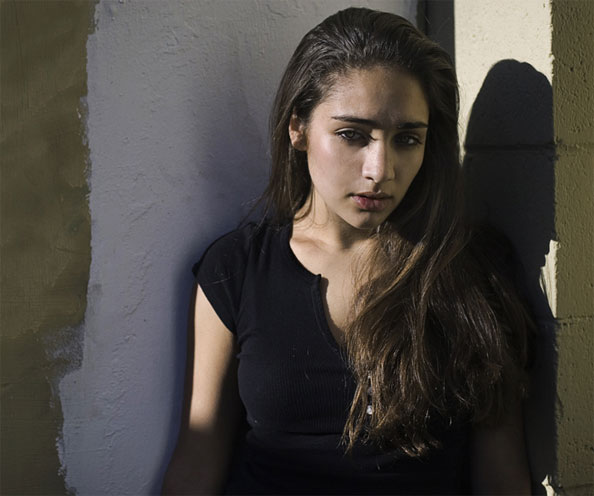
This photo fills me with wonder. What’s going on? Why is she stood in the sunshine in front of a half-pointed wall? Her eyes are kind of closed. Is she tired? Is she reacting to the sun? Is she on drugs? She does look sort of suspicious. Is she trying to hide from something or someone? Is she suspicious herself, of does she mistrust the photographer? Is she angry at the photographer?
With an initial impression like that, you’re bound to catch the attention of onlookers, which is a great start in the battle towards getting a photo noticed.
On a technical level, I think I’m not too fond of the sharp side-light. The shadow of her eyelashes on her nose is not particularly flattering, and while it does look as if you’ve used a reflector to lighten up the ‘dark’ side of her face (did you? Or is it merely light reflected back off the wall? It doesn’t look as if there is enough wall surface for that amount of light reflection), it isn’t quite enough. The main thing I have a problem with from a technical point of view, is that even in this photo, it’s possible to see that the model has absolutely gorgeous eyes. We want to be able to see them properly! A fill-flash would definitely have come in handy here. While you’re at it, perhaps a little bit more light on the wall behind the model as well — the sharp contrast between the white and the light olive colours carry this image — use it!
Right, with all that out of the way, let me say that this image is bloody good. Just like the first image, it harbours a lot of emotion and it tells (or rather, hides) a story. The light is low on the horizon, which to me says ‘evening’ or ‘morning’. Based on the make-up, I want to think evening. Or is it morning? Is her tiredness because she’s been out all night? But she doesn’t sweaty or messy enough to be out all night…
Obviously, I haven’t got the faintest idea who the model is, nor what her relationship to the photographer is, nor what her personality is like. Conflicting images of misspent youth, worry, intelligence, drug abuse, perhaps. Whatever it is, this photo oozes feeling, emotion, and — yes — soul.
Right, I do realise that this is the least useful critique I’ve done on here in a long time. There’s just something that really works in this image, and it drives me spare that I can’t put my finger on what it is. I have an idea I’ll come back to this image many times in the future, and every time, I’ll be left wondering. It’s a sign of unbridled greatness. Sort out the technical details, and you’re on to a proper winner. Thank you so much for sharing this.
Can anybody else add anything to the critiques? Do you agree? Not sure? Do you completely disagree? Well that’s what the comments are for.
Do you enjoy a smattering of random photography links? Well, squire, I welcome thee to join me on Twitter -
© Kamps Consulting Ltd. This article is licenced for use on Pixiq only. Please do not reproduce wholly or in part without a license. More info.











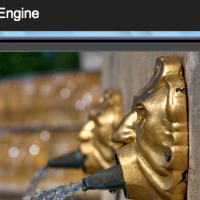



 How does having your photos printed on glass sound to you? A minimalist photo-and-frame-rolled-into-one deal, if you like. It’s what the guys over at Fracture can do to your pictures. No, there’s no paper involved; the image goes on the glass. No, I’ve not a clue how they do it. But I really wanted to know what they’re like, so I checked them out.
How does having your photos printed on glass sound to you? A minimalist photo-and-frame-rolled-into-one deal, if you like. It’s what the guys over at Fracture can do to your pictures. No, there’s no paper involved; the image goes on the glass. No, I’ve not a clue how they do it. But I really wanted to know what they’re like, so I checked them out.



